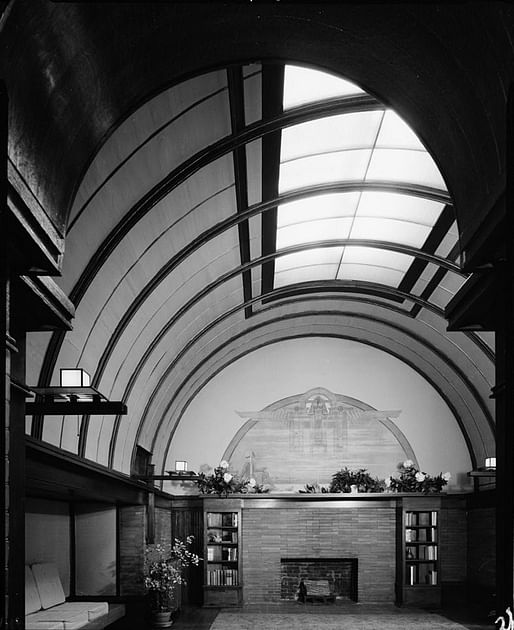
For decades, fans of Frank Lloyd Wright have made the journey to the small residential neighborhood of Oak Park, Illinois to where the architect built more than 25 structures during the first half of his career. Of greatest significance is the home and studio he built for himself in 1889, which has been open to the public since 1976 after it was declared a National Historic Landmark.

In an effort to preserve the look and feel of the Frank Lloyd Wright Home and Studio campus, little has been added or reorganized at the site. The newest addition to the campus, however, will be a visitor and Education center designed by Chicago-based John Ronan Architects.
At first glance, the renderings of the visitor and education center bears little resemblance to the work of Frank Lloyd Wright, and even less to any of the buildings on the campus of which it will soon be a part. From a distance, the design bears a greater resemblance to the early work of Mies van Der Rohe, an architect openly despised by Wright. However, upon closer inspection, the design appears to take subtle cues from Wright's oeuvre as well as draw little attention to itself in reverence of the historic buildings that surround it.
The firm has designed the center as an educational tool in itself, hoping to tie the many elements of the site's history together According to the firm, "The design takes as its point of departure the garden wall which surrounds the site and binds all the chapters of history together like the jacket of a book. This wall, which has evolved many times over its lifespan, currently ends at the east property line like an unfinished sentence. We propose to extend this wall along the east and south property lines to complete it and define the campus. The visitor center becomes part of this garden wall, a discreet presence foregrounding the existing buildings on the site, more part of the site infrastructure than a competing architectural element."
In designing the general profile of the visitor profile, the firm was influenced by the Prairie Style, an architectural movement pioneered for the American midwest by Wright which intends to harmonize with the landscape by lying long and low. The visitor center is "recessed from the street and sunk down from street level" to achieve this effect in a way Wright never had before.
Though the design was approved the Frank Lloyd Wright Trust, there is no official opening date as of yet.
10 Comments
There are plenty of unbuilt or built but subsequently lost Wright buildings to satisfy this requirement. Here is Wright's pavilion for Banff in Canada, built 1914, demolished 1938. What was the Wright Foundation thinking?
wrights own home and studio are so dissimilar from his later works i think this kind of more generic space makes sense. a 'wright' style building would just confuse things and distract from the house. i think this is the right approach.
plus, mies wins!
it is odd though that none of the selected images show the original building at all. hard to seriously evaluate it without context.
It’s a banal design and does absolutely nothing that advances architecture that Wright advocated.
It is just a building not architecture
Boring.
Saying Wright “openly despised Mies” is a simplification — there was a lot more respect there than to Mies’ imitators. Wright introduced Mies to Chicago and based much of his later career on Bauhaus influences, with his own unique perspective. There is no Fallingwater without Mies. Just like the NYT fake arch critic said FLW hated cities and NY ... right, so much he lived in Chicago and built one of the best buildings in NY and designed many more. Like any architect, he thought he could do better, or liked some aspects but not all. Which is more nuanced than saying he hated this or hated that.
As for this project, I’m surprised it is necessary, as the appeal of the Home/Studio is it feels like a home/studio in a neighborhood, and a starting point to tour other FLW Chicago buildings. You could build this education center elsewhere and have a better effect.
Well, if you want to make a statement about FLW they could have rebuilt the Pawson house. It was built in Phoenix in 1939 and burned in 1943. Which building had you rather visit, this or the anemic 'visitor center'? Something is not passing the smell test here.
do you feel like rebuilding a desert retreat house in suburban chicago as a visitors center is an appropriate reflection of wright's ideals? sell the soul to save the body...
The Pawson house reflects Wright's being influenced by the Chicago Colombian World Exposition of 1893. The above building reflects the Mayan architecture he was exposed to there. Much of the Mayan architecture was not built in the desert, but the jungle. There was also a Mayan Revival in the 1920's and 1930's in this country.
Anonymous corporate architecture. Looks like a grade school or municipal building. Does not merit comparison or reference to Mies let alone Wright.
Block this user
Are you sure you want to block this user and hide all related comments throughout the site?
Archinect
This is your first comment on Archinect. Your comment will be visible once approved.